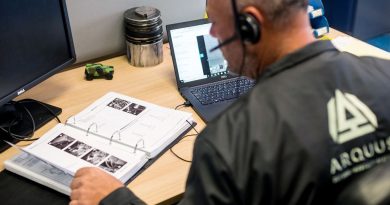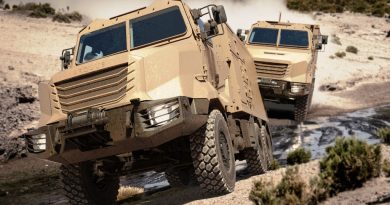Eurosatory 2024 – MAV’Rx brings Arquus on the frontline
At Eurosatory 2024 Arquus unveils a new 4×4 armoured vehicle prototype designed to ensure high mobility and protection, its primary mission being to carry troops on the frontline and support them with credible firepower
With priority switching from peace support operations to high intensity conflicts the need for a wheeled armoured personnel carrier (APC) capable to operate not as a battle taxi but as a vehicle that can also provide the infantry squad with adequate firepower, while ensuring a good level of protection when on the move, is surfacing again. The Arquus portfolio did not contained such a vehicle, hence a few years ago the decision was taken to develop a wholly new 4×4 armoured vehicle, the MAV’Rx.
The 19-tonne vehicle completes the company offer, design priorities being outstanding mobility, very high survivability and good firepower, coupled to high maintainability on the field. The MAV’Rx, which development is entirely done with company funds, will not be visible to all Eurosatory visitors, at it is being exhibited in a screened section of the stand.
The vehicle is 6.98 metres long, 2.55 metres wide and 2.73 metres high at the roof. In the APC configuration the MAV’Rx can carry the driver, the commander, and a firing section of eight dismounts. The former access and egress the vehicle using the two cabin side doors, while the latter do it through the rear ramp, all being electrically actuated. Arquus maintains that a search for the best compromise between compactness, hence ability on the terrain, and comfort was carried out, considering 95 percentile of personnel with a height of over 190 centimetres and broad shoulders. All are seated on energy absorbing seats, enough room being available behind the seats to host rucksacks. To improve comfort seats are scaled laterally. Air conditioning and heating have been dimensioned to provide maximum comfort in extreme temperature conditions.
The new platform is inherently multirole, and while the prototype shown at the Paris exhibition was in the APC configuration, fitted with a 25 mm turret by John Cockerill Defence, further versions in command post, CASEVAC, mortar carrier and reconnaissance configurations might well be developed.
Coming to mobility, the 8 litres 6 cylinders 400 hp engine is located at the front, which allows direct contact between the crew and dismounts, and is coupled to a 7-speed automatic transmission. The MAV’Rx is fitted with double wishbone independent suspensions with coil spring and shock absorber, central tire inflation system and run flat inserts being standard on the 14.00 R20 tires. The vehicle will be capable to overcome a 60% slope, and travel on a 30% side slope, it can ford a 1.2 metres deep water obstacle without preparation, overcome a 0.5 metres vertical obstacle, a 1 metre trench. As the amphibious capability is not among top priorities of most armies Arquus decided not to consider it yet. Currently based on a conventional propulsion, nonetheless the vehicle roadmap might well include a hybrid solution, Arquus being fully involved in diesel-electric solutions; its VAB Electer is shown at Eurosatory as a demonstrator for specific functions, while the Scarabee has proved its value in numerous demonstrations.
The Arquus research and development division developed and is continuing working on new armour solutions, protection packages being constantly improved. For the MAV’Rx the company R&D developed a high protection all round solution, ballistic and blast, which level remains of course classified. Transparent armour being a critical issue when talking ballistic resistance, according to Arquus a compromise was found between the direct view available to the driver and commander and the size of the windscreen. The design took into consideration since inception the possible adoption of an active protection system, to further improve the MAV’Rx survivability. The vehicle is obviously equipped with CBRNB filtration system and with a fire extinguishing system both in the engine and in the passengers’ compartment.
The roof was designed to cope with medium calibre turrets, which mass can reach around 1.5 tonne. This also means the protection from some of the top attack threats can be dealt with. Arquus declares a payload capacity ranging from 2.5 to 4 tonne, depending on the protection level.
The new APC is fitted with a digital cockpit for the pilot, who can retrieve all needed info, the system being designed to lower as much as possible the cognitive. The same applies to the commander’s station; the MAV’Rx is designed around the company BattleNet vetronic architecture that allows fusing all data coming from the various sensors presenting them on the screen, the human-machine interface being designed to improve the tactical awareness while decreasing reaction times.
A second screen can be made available to the section commander; this will very much depend on the doctrine of the army, solutions being considered case by case. The same applies to the gunner position, a dedicated gunner reducing the dismounted section to seven soldiers.
Maintainability has been considered since inception. Rapid field-repair capacity is a priority for a combat vehicle, hence the designers made sure that a quick powerpack replacement was feasible, Arquus stating that this can be done in less than two hours at unit level. Access to critical components has been carefully considered, the front engine under the bonnet allowing easy repair, a diagnostic case being available on board. HUMS (Health and Usage Monitoring System) sensors will be present on serial production vehicles, allowing maintenance optimisation.
Beside remotely controlled turrets, other weapon systems can be installed, the MAV’Rx being apt to fill numerous roles. Antitank missile turrets, C-UAS systems, VSHORAD solutions, can all be potential weapon systems for the new Arquus APC, beside the typical variants already mentioned. Considering the increasing power requirement, the company is considering the adoption of an auxiliary power unit (APU), to be installed at least on some of the variants.
Considering its dimensions and mass, the MAV’Rx is easily transportable by an A400M Atlas aircraft.
EDR On-Line understood that the new APC has conducted limited mobility trials prior to Eurosatory, most of the industry trials being planned after the Paris exhibition.
Marketwise, while of course the new vehicle is being proposed to the national customer, Arquus is however mainly looking at export, NATO countries being considered as the most probable potential customers of the newly designed MAV’Rx.
Photos by P. Valpolini







